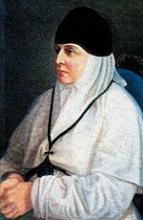Bright Thursday and October 20/November 2
 On January 24 of this year, the Holy Protection Convent in Kiev celebrated the glorification its founder, St. Anastasia (Grand Duchess Alexandra Petrovna Romanova), as a locally-venerated saint.
On January 24 of this year, the Holy Protection Convent in Kiev celebrated the glorification its founder, St. Anastasia (Grand Duchess Alexandra Petrovna Romanova), as a locally-venerated saint.
The solemn glorification took place during the Divine Liturgy served by His Beatitude Metropolitan Vladimir of Kiev and all Ukraine in the Convent’s St. Nicholas Church.
At the conclusion of the Service, Metropolitan Vladimir and the clergy concelebrating with him venerated the most-precious relics of the Saint, and then congratulated the assembled faithful on the occasion of the glorification of Nun Anastasia as a saint.
Nun Anastasia of Kiev (Grand Duchess Alexandra Petrovna, born May 2, 1838 in St. Petersburg, reposed April 4, 1900 in Kiev) was the daughter of the renowned philanthropist Prince Peter Georgievitch Oldenburg. She was baptized according to a Protestant rite, with the name Alexandra Frederica Wilhelmina. She inherited her father’s social outlook, and already in youth would render assistance to poor and sick children.
On February 25, 1856, she converted to Orthodoxy with the name Alexandra, and married Grand Duke Nikolai Nikolaevitch, the brother of Emperor Alexander II. The couple had two sons, Grand Dukes Nikolai and Peter.
In St. Petersburg, the Grand Duchess established the Holy Protection Society of Sisters of Mercy, a hospital, a clinic, a girls’ orphanage, a school for training medics, and other charitable institutions. Until 1881 she was director of the council of children’s orphanages under the Department established by Empress Maria Fyodorovna and headed by Prince Oldenburg. Thanks to the efforts of the Grand Duchess, sufficient capital was raised to support 23 orphanages, housing 5,000 orphans. During the Russo-Turkish War, the Grand Duchess used her personal funds to organize a team of medics.
In 1879 the Grand Duchess went abroad to seek treatment for her breast cancer. In 1880 she moved to Kiev; in 1889 she established the Holy Protection Convent there, and settled in the Convent. There the Grand Duchess, who for years had been bedridden, was miraculously healed, and began to walk.
After her husband’s death (April 13, 1891), she was secretly tonsured a nun, and was given the name Anastasia.
At the Holy Protection Convent, Nun Anastasia opened a hospital for the indigent, with Kiev’s only department of radiology; she established a free pharmacy, a school and orphanage for orphaned girls, a hospice for terminally ill women, and a refuge for the blind.
Life for the sisters of the Convent followed the Rule of the Studion Monastery – a strict and selfless life of prayer and work. Nonetheless, during its first year, there were 400 applicants to join the Convent, which at the time could house only 150 nuns.
Nun Anastasia observed a strict fast, lived in a simple cell, and would give all of her resources toward maintenance of the institutions she had established. During surgical procedures, she worked as a surgeon’s assistant. She oversaw hospital operation, preparations for surgery, and the feeding and spiritual life of the sick. She tended patients recovering from surgery, and raised the spirits of the sick. In 1897, Anastasia organized several specialized hospitals to deal with and avert an epidemic of typhus in Kiev. Until 1894, when her health began to worsen and she herself had to undergo surgery, Nun Anastasia attended all monastic services, and herself chanted the Six Psalms, Hours and Canon.
“The Duchess’ Monastery,” as the Holy Protection Convent was known, was important in the areas of missionary and educational activity. At the Convent there was a bookstore and an icon shop, and the Convent published great quantities of religious/educational brochures. As the result of the gentle treatment they received and their discussions with the Grand Duchess, many Evangelical Baptist girls rooming at the Convent eventually returned to Orthodoxy.
In 1894, the Mezhigorsky Monastery of the Transfiguration, redesignated as a women’s monastery, was attached to the Holy Protection Monastery. During a visit by the Emperor St. Nicholas II and Empress St. Alexandra Fyodorovna in 1896, the cornerstone of the new Cathedral of St. Nicholas, designed by Grand Duke Peter Nikolaevitch, was laid at the Holy Protection Convent. With funds donated by the Emperor, in 1897-1898 a new hospital building was erected and medical facilities greatly improved.
On Tuesday of Bright Week, after a great deal of suffering, Nun Anastasia reposed. Following the funeral service, which was attended by a great number of people, she was interred opposite the Altar of the Holy Protection Church in the Convent she had founded.
